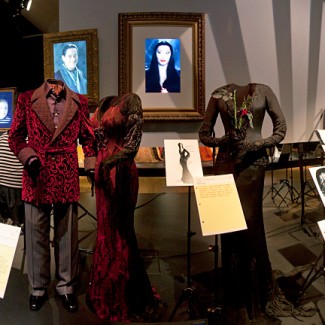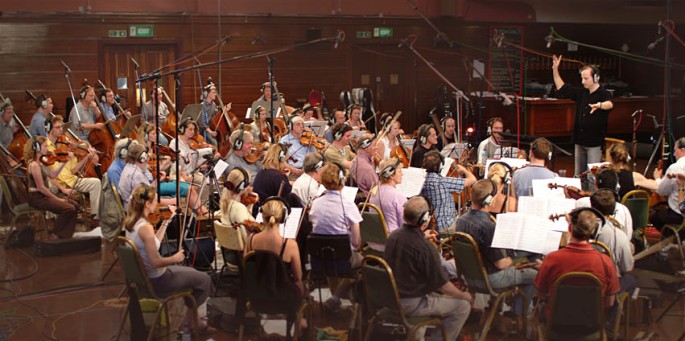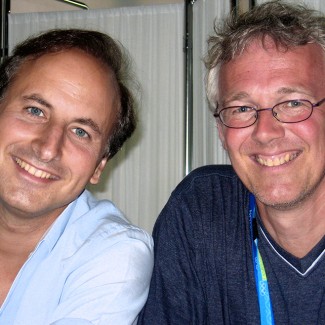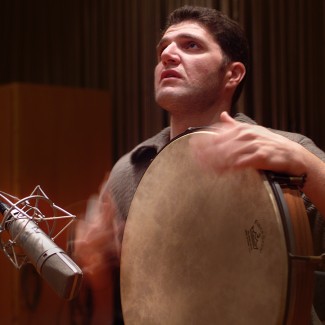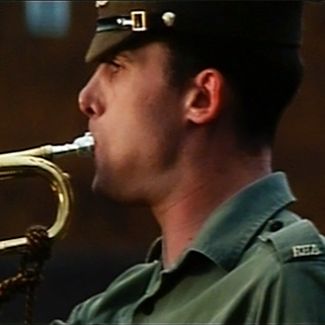Hollywood Costume
Hollywood Costume – V&A London, The Academy Museum Los Angeles, International Tour
Hollywood Costume is a ground breaking exhibition exploring the central role costume design plays in cinema storytelling. Conceived by Oscar nominated Deborah Landis and researched over a five year period the record breaking show was was sold out for the duration of it’s six month London run with over 265,000 visitors. There followed an international tour due to conclude at the Academy Museum in Los Angeles.
The exhibition spread over three entire galleries featured highly innovative design from London agency Casson Mann under the creative direction of Roger Mann.
The soundtrack to the exhibition had a number of challenges. Deborah didn’t want background music but a captivating score reflecting the emotions of blockbuster movies across the decades.
Visual media was produced with a short loop duration to inform a moving audience however due to the open and reflective nature of the galleries a repetitive theme of short duration could have detracted from the experience.
The solution was a score that evolved over a number of minutes yet had a tempo framework allowing the visual media to repeat yet remain in synchronization with the music. The galleries were also divided into four zones with synchronous but varying orchestrations evolving as the visitor passed through the exhibits moving from romantic Hollywood via action percussion to baroque for the historical sections. This removed the usual audio clashes that occur when numerous soundtracks are played in an open space.
A specially designed sound system with studio quality monitors was installed across the three galleries. In each space the music was mixed on the system to match the gallery acoustics prior to transfer to the show system. This enabled a more theatre like sound quality to be achieved.
In the second gallery where there were a number of interview recordings the soundtrack had neutral mixes in the busier areas morphing into stronger movements where a more dynamic presentation suited. Although there was a common theme across the whole exhibition the design of the music created a linear duration of 90 minutes so the visitor could enjoy an extended view of the displays without repetitive audio content.
An example of how the music was scored to evolve across a gallery can be heard on the audio player (Hollywood Costume transitions). This illustrates how the orchestration seamlessly evolves between zones without clashes.
Credits
Pictures courtesy of Keith Lodwick
Conceived and curated by Deborah Nadoolman Landis
Guest Curator – Sir Christopher Frayling
V&A Curator – Keith Lodwick
Producer – Sue Joly
Creative Direction – Roger Mann for Casson Mann
Associate Designer – Gary Shelley
Design – Virna Di Schiavi
Music Concept/Composition – Julian Scott
Orchestrations – Jill Jarman
Video Production – Picture Production Company
Software Production – Squint Opera
Lighting – DHA Design Services
Systems Design – Graeme Bunyan for Sysco A/V
Olympic Games case study
Five hours of music, two symphony orchestras, two Greek popular orchestras, numerous choirs, ethnic groups and solo performers…
The Opening and Closing Ceremonies of the Athens 2004 Olympic Games captured a global TV audience in excess of 4 billion.
Julian led the project for an 18 month period from June 2003 utilizing a production technique and workflow that could accomodate a continually changing brief, yet still deliver an Opening and Closing Ceremony soundtrack compatible with both a Greek music recording legacy and the requirements of a worldwide broadcast.
The 2004 ceremonies were the first to be produced by a non- indigenous company. Jack Morton Public Events, the producers, assembled a team from across the globe to assist Greece in creating what was universally acknowledged as “a triumph”. At the time of the Opening Ceremony the core production team numbered 430.
State of the art technology was utilized throughout the production, from intitial music preparation through to major structural engineering, creating representions of both ancient and modern Greece, including flooding the Olympic Stadium, a 60-foot high cycladic head emerging from the resulting “sea”, splitting to reveal two statues, then fragmenting into 18 sections depicting the Greek islands.
Despite the huge scale of the event the music still was able to visit areas of both intimacy and reflection.
All the recordings were made directly to disc using Apple’s Logic Pro with Metric Halo audio interfaces. We utilized 4 systems to enable recordings to be made concurrently and any system could instantly be set up to preview or work on a mix. The maximum number of track used in a mix was 255 for one of the more complicated arrangements.
Wherever possible the recordings were made in sections (separate parts of the orchestra playing at different times) to enable there to be flexibility – this allowed the creative development of the ceremonies to continue after the recordings had been made, by offering the capability to re-arrange the music as well as edit the duration.
The recording venues were mostly in Athens, with the Megaron (Athens Concert Hall) and Sierra Studios providing the main facilities.
Mixing, was carried out in Sound Affects studios in the UK, at a specially constructed studio in Jack Morton’s Athens production office, and also by Paul Stefanidis (who handled a lot of the recording and mixing duties) in his own facilities.
Harbeth professional monitoring loudspeakers were used throughout the project in different studios to ensure consistency.
We recorded the ERT symphony orchestra in the main concert hall in Athens and made further recordings with the Royal Philharmonic Orchestra in Watford, England. All orchestral rehearsals and recordings were under the baton of top Greek conductor Miltos Logiadis.
As well as conventional orchestral recordings we made numerous recordings of Greek instruments including Lyras, Gaidas, Ouds, Santours, Lutes, and of course Bouzoukis – 50 of them!
Further details can be viewed by clicking the links below:
Credits
Artistic Director – Dimitris Papaioannou
Director of Public Events Jack Morton Worldwide – David Zolkwer
Music Concept Creator – Yorghos Koumendakis
Music Associate – Maria Metaxaki
Video Director – Athina Tsangari
Lighting – Eleftheria Deko, Robert A. Dickinson
Choreography – Angeliki Stellatou
Conductor – Miltos Logiadis
Executive Producer – Andrew Walsh
Music Department:
Music, Music Production – Julian Scott
Associate Producer – Marcus Dillistone
Coordinator – Vassilia Katsani
Soundtrack Production Supervisor – Paul Stephanidis
Recording Engineer – Dick Lewzey
Commonwealth Games study
The Commonwealth Games was both the largest and most successful sporting event to be hosted by the United Kingdom in recent history. A contributory factor to their success were the Opening and closing ceremonies.
Julian was commissioned, by artistic director David Zolkwer, to score some of the key moments including the centerpiece arrival of the baton.
The Royal Philharmonic Orchestra and The Joyful Company of Singers were recorded at the Coliseum in London. Unusually the sections of the orchestra and choir were recorded over a number of separate sessions, this was to ensure that maximum flexibility for on-site mixing and editing was maintained and to allow for last minute changes.
As well as providing a suite of symphonic music the producers asked Julian to co-ordinate the presentation and mixing of all the diverse musical elements that comprised the shows.
These varied from Gamelan to Classical and Marches to Club Grooves.
A temporary multitrack studio was installed within the stadium complex and from here broadcast and live mixes were created with changes being made right up to the final night.
The studio was connected to the main stadium system as well as to the broadcast hubs so the music was fine tuned for both live audience and the one billion listeners worldwide.
Further audio clips can be heard on the Commonwealth Games project page
Read the Metric Halo press release about Julian’s sound production for the games.
The Troop Film
The Troop film sets out to capture the sheer power and grace of The King’s Troop royal horse artillery. Award winning director Marcus Dillistone, noted for his demanding sound requirements, commissioned Julian to score the film and also oversee the location and post production sound.
As well as recording during filming, the entire King’s Troop were made available for a special sound shoot. Microphones were strapped to gun carriages, horses and riders, and for that final bit of realism 12 tons of horse and gun were galloped past the sound recordist with inches to spare.
Unlike nearly all modern features the Troops soundtrack was created from the actual sounds of the Troop with no artificial processing. The music score was crafted to allow space for these fx resulting in a powerful dynamic soundscape to complement stunning cinematography.
EMI Music 100
Music 100 was large scale interactive public exhibition tracing the history of sound and marking the Centenary of EMI. Technologies explored ranged from the first wax cylinders to digital multit-racks and surround sound.
The exhibition was opened by Diana Ross at Gallery West in docklands, London with proceeds donated to the Music Sound Federation.
As well as composing a number of original works, including an introductory piece “The Drum” Julian also worked closely with the curators in the selection and preparation of hundreds of audio archives to represent the history of recorded sound and music. Editing, production and technical management was provided to ensure a dynamic cohesive presentation of the material.
Close co-operation was maintained with the designers and installers of the complex replay systems with particular attention being given to how multiple sound systems interacted over the total exhibition space.
In excess of 300 individual soundtracks were produced by Julian representing the sonic highlights of the past century. These included extracts as diverse as “Soldiers of the Queen” from 1898, Caruso the opera singer, King George V, and an amateur recording of the Quarry Men (later known as The Beatles) at a church fete on 6th July 1957 the day John Lennon met Paul McCartney.
There were also interactive multitrack and surround sound demonstrations recreating the inner workings of a top recording studio.
Listen to The Drum and original composition commissioned for the exhibition.
Credits
Music 100 was produced by Sue Joly for Purchasepoint
Original Music, Soundtrack Research and Production – Julian Scott
Director of External Affairs EMI – David Hughes


